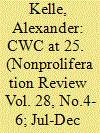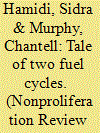|
|
|
Sort Order |
|
|
|
Items / Page
|
|
|
|
|
|
|
| Srl | Item |
| 1 |
ID:
191978


|
|
|
|
|
| Summary/Abstract |
This article analyzes the shifting focus of the Chemical Weapons Convention (CWC) during the first 25 years of its implementation, from the verification of destruction of declared chemical-weapon (CW) stockpiles to the attribution of CW use. The article identifies the repeated use of chemical weapons by Syria and the resultant creation of a new attribution norm under the CWC as a critical juncture in the regime’s evolution. Repeated calls for accountability for the use of so-called Novichok nerve agents for assassination purposes serve as the first manifestation of the new attribution norm. The article further outlines steps CWC states parties should take in the context of the Fifth CWC Review Conference in May 2023 to prepare the CW-prohibition regime for its next 25 years of operation by (1) adapting the implementation of key regime norms following the anticipated completion of CW destruction later in 2023 and (2) incorporating the investigation and attribution work of the Investigation and Identification Team into the programmatic work of the OPCW.
|
|
|
|
|
|
|
|
|
|
|
|
|
|
|
|
| 2 |
ID:
191976


|
|
|
|
|
| Summary/Abstract |
Over the past two decades, the international community has devoted considerable attention to the human dimension of nuclear security. This trend is part of a more holistic approach to securing nuclear facilities, grounded in the concept of culture, that moves beyond the traditional focus of physical-protection measures. But what explains this shift and what does it entail? This article begins by demonstrating, through a series of real-life case studies, the potential for human factors to undermine nuclear-security systems. It then considers the rise and consolidation of “culture” as a concept used to better understand and organize international efforts to strengthen nuclear security. Nuclear-security culture is then explored in practice, drawing on a review of relevant initiatives as well as empirical research conducted by the authors at several UK nuclear sites. A number of likely challenges for developing an effective nuclear-security culture at the operational level are discussed, as is the value of the culture-focused guidance developed by the International Atomic Energy Agency. The article concludes that while nuclear-security culture has been widely promoted at the international level, there exists considerable scope for new initiatives to further strengthen engagement at the working level of industry.
|
|
|
|
|
|
|
|
|
|
|
|
|
|
|
|
| 3 |
ID:
191979


|
|
|
|
|
| Summary/Abstract |
Incidents of noncompliance with existing multilateral arms-control treaties and subsequent enforcement actions can help to inform the design of future treaties. This article uses examples of noncompliance with the 1972 Biological and Toxin Weapons Convention, 1993 Chemical Weapons Convention, and 1968 Treaty on the Non-Proliferation of Nuclear Weapons to identify factors that have determined the nature of compliance-enforcement actions. The punitivist model of treaty design and enforcement is introduced and is used alongside the established transformationalist and managerialist models to analyze incidents of noncompliance and identify factors shaping compliance-enforcement actions. Two such factors are found to play important roles: the scale of acts of noncompliance and the identity of the perpetrator. The scale of the act of noncompliance dictates whether the compliance-enforcement actions specified in the treaty text are followed. Responses to large-scale acts do follow the treaty-specified actions, while the small-scale acts analyzed in this article all elicit a managerialist response of consultation and cooperation, regardless of actions stipulated in the treaty text. In all cases, the identity of the perpetrator is crucial: the permanent members of the UN Security Council and their allies are fundamentally impervious to punitive measures.
|
|
|
|
|
|
|
|
|
|
|
|
|
|
|
|
| 4 |
ID:
191981


|
|
|
|
|
| Summary/Abstract |
There is much ado nowadays about the flagging commercial nuclear industry in the United States. Although the country maintains the largest global fleet of reactors, more than one-third operate at a loss, and the industry is on pace to lose more than 20 percent of its generating capacity by 2050.Footnote1 This crisis is unfolding as Russia’s state-owned nuclear industry has become the largest global supplier of new nuclear reactors, driven by its build-own-operate export model and Russian government financing for international reactor projects. This financing is “large (in total amount provided), cheap (with low interest rates) and long-lived (with long repayment periods).”Footnote2 Not surprisingly, many US nuclear officials, policy experts, and corporate leaders fear that without concerted government intervention, the US nuclear industry is teetering on the precipice of irrelevance as a strategic global supplier, just as the prospects for long-term strategic confrontation with Moscow are materializing with Vladimir Putin’s war in Ukraine.Footnote
|
|
|
|
|
|
|
|
|
|
|
|
|
|
|
|
| 5 |
ID:
191980


|
|
|
|
|
| Summary/Abstract |
In the early 2000s, the George W. Bush administration condemned Iran’s use of nuclear-fuel-cycle technologies while endorsing sensitive nuclear activities in South Korea. The politics behind this difference may appear self-evident, but maintaining this policy was premised on a complex interaction between technology and politics. This paper examines both US and international definitions of uranium enrichment and spent-fuel reprocessing and finds an incoherence between technical definitions and policy implementation. Definitions of enrichment are narrow, as they refer to a very specific set of material processes. But the Bush administration applied a capacious standard when debating what it meant for Iran to “suspend” enrichment-related activities. On the other hand, definitions of reprocessing are capacious, implicating many different processes that can be interpreted as reprocessing. And yet the Bush administration applied a narrow standard as it sought to assist South Korea’s pyroprocessing efforts. By positing a reciprocal relationship between technology and politics, this article challenges both the position that technical solutions can solve entrenched political conflicts, and also the simplified narrative that great-power politics trumps shared technical and legal standards. Interpretive conflicts over technical standards are shaped by politics, and yet technical contestation also limits and bounds political manipulation.
|
|
|
|
|
|
|
|
|
|
|
|
|
|
|
|
| 6 |
ID:
191977


|
|
|
|
|
| Summary/Abstract |
In 1991, international inspectors discovered Iraq’s clandestine nuclear-weapons program. In seeking this capability, Iraq was violating its commitment to the 1968 Treaty on the Non-Proliferation of Nuclear Weapons. After this discovery, the international community and the International Atomic Energy Agency worked to improve nuclear safeguards so that secret nuclear-weapons activities would be more easily detected in the future. One of these improvements was the 1997 Model Additional Protocol. This article explores the value of the Additional Protocol and argues that it is the strongest signal available to states that they support the nuclear nonproliferation regime and have benign nuclear intentions. The article then assesses the reasons why several notable holdout states remain.
|
|
|
|
|
|
|
|
|
|
|
|
|
|
|
|
|
|
|
|
|